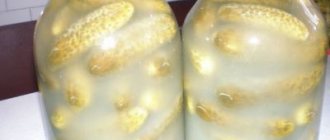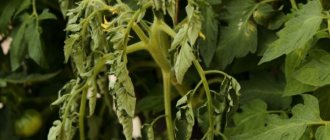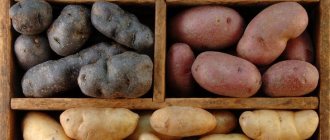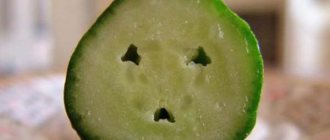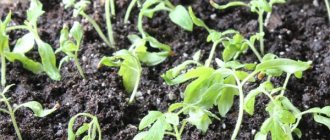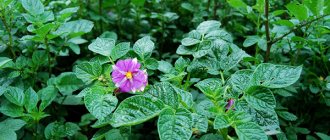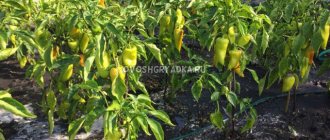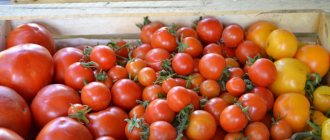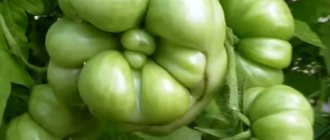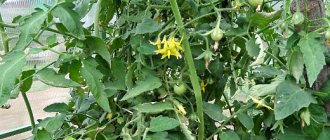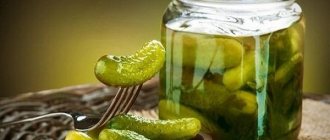Features of the variety
Some hybrid tomato varieties have a specific gene that causes white veins to appear inside the fruit. They provide a strong base for tomatoes, which helps them maintain their shape and attractive appearance much longer. This helps the manufacturer to easily transport the crop without worrying about its integrity.
But tomatoes grown from such varieties are hard and lack a strong taste, so ordinary gardeners practically do not use them. To avoid planting this variety by mistake, study all the features of the selected seeds before purchasing them.
Not enough nutrients
A lack of potassium is manifested by hard fibers inside the berry, uneven coloring of the fruit, a dry border on the edges of the foliage, and curling of young shoots into tubes. Calcium deficiency leads to spoilage of tomatoes: their nose turns black and dries out. Young leaves begin to turn yellow and take on a scorched appearance, while older foliage turns dark brown.
In such a situation, it is necessary to feed the plant with potassium sulfate, calcium nitrate or wood ash. These substances will provide the culture with the necessary beneficial elements.
Fusarium
This fungal disease can greatly harm tomatoes. If you do not notice the appearance of fusarium, it will gradually affect all tissues of the plant, which will lead to rotting and death of the entire bush.
The main signs of fusarium are yellowed and curled leaves, as well as discolored veins through which the plant sap flows.
When the first signs of the disease appear, treat the infected bush with Trichodermin. This biological agent does not harm fruits; it can also be used as a preventive measure.
If you need a stronger remedy, choose a chemical preparation, for example, Falcon or Previkur. But keep in mind that in this case, the fruits from the treated bush cannot be eaten for the next 3-4 weeks.
Lack of microelements
Uneven ripening of fruits and at the same time the presence of white, hard veins inside them is often caused by a lack of potassium, calcium and magnesium (mainly potassium). This can happen even if there are enough of these elements in the soil. Why are tomatoes starving? There could be several reasons for this.
Too hot
At high temperatures (from 35 degrees), tomatoes lose the ability to absorb potassium, as a result of which they fail to ripen at the stalk. At the same time, tomatoes stop producing lycopene. This element is responsible for the production of red pigment (by the way, it is this element that makes tomatoes help fight cancer and helps maintain youth).
Little light
If the plantings are very dense or if the green mass grows too much, the tomatoes at the base may not have enough light. This negatively affects both the formation of lycopene and the absorption of potassium and magnesium.
Excess nitrogen
Many gardeners fertilize tomatoes too generously with manure, which contains a lot of nitrogen, or abuse mineral fertilizers rich in this element. With an excess of nitrogen, tomatoes absorb potassium, calcium and magnesium worse, with all the ensuing consequences.
Lack of moisture
If the summer is dry and you are not able to water the tomato beds as often and as abundantly as required, the absorption of nutrients from the soil by the roots becomes difficult. As a result, the tomatoes do not ripen completely and are light and hard inside.
Failure to fertilize
If you have not added mineral fertilizers to the soil this season, the tomatoes will almost certainly “starve.” This will negatively affect the speed of their maturation.
How to diagnose potassium deficiency
If the tomatoes are white and hard inside, only half ripen (do not turn red at the stem), then all the signs of potassium starvation are evident. But if you need further evidence, inspect the leaves. If you observe a marginal burn on the lower leaves, then the plant is clearly lacking potassium.
What to do to solve the problem
A number of measures can be proposed to solve the problem of uneven ripening of tomatoes and whitening of their flesh for physiological reasons.
- If you grow tomatoes in a greenhouse, try whitewashing the roof.
- Do not overfeed tomatoes with nitrogen; rely on potash fertilizers. Feed the bushes with a complex mineral fertilizer with a high potassium content and low nitrogen content (or better yet, no nitrogen at all).
- Normalize the watering regime.
In the future, try not to plant tomato bushes too close to each other. If your weather is often too hot, give preference to varieties with a short ripening period.
Heat
If the ambient temperature rises above 30°C, tomatoes cannot normally absorb potassium and produce lycopene, which gives the fruit its red color.
Because of this, the tomato pulp becomes tasteless and pale, so it is important to make every effort to increase air humidity and reduce temperature. To do this, you need to water more often, open the door and windows in the greenhouses, use a fan if necessary, and place several containers of water next to the tomato bushes.
Useful tips
To somehow soften the rough pulp, experienced summer residents suggest using the following recommendations:
- if immaturity is a varietal factor, then the picked tomatoes should be placed next to the ripe fruits; in a few days they will reach the desired stage and become more edible;
- to prevent contamination of the crop with viruses, the bed should be treated with garlic infusion every week; to prepare it, take cut teeth from one head and fill with 5 liters of water; leave for 2-3 days;
- if aphids appear on the bushes, you should release ladybugs into the garden bed (15-20 pieces will be enough); they will quickly destroy the pest;
- in the hot season, when the bushes do not have enough watering, it is recommended to use an air humidification system to reduce its temperature;
- Once a week, up to 5 liters of water should be added to each bush.
If tomatoes are grown in a greenhouse, then you can lower the air temperature to the optimum (+20-25 degrees) by evenly placing open vessels with water in the room.
Stolbur
Symptoms of this viral disease can be noticed even before the fruits appear. First, small leaves appear, then they acquire a pinkish tint, and their edges gradually bend upward. After this, the stem of the plant thickens, pale and fused flowers are formed, and the fruits receive uneven pigmentation.
The problem is that stolbur is not curable, so all infected bushes need to be dug up and burned. To stop its spread, you will have to get rid of weeds growing near tomatoes and harmful insects such as aphids, whiteflies and cutworms. Both of them are carriers of stolbur, posing a threat to vegetables.
Reasons for the appearance of white veins in tomatoes
The problem of hard white veins inside a tomato is not an isolated case. Such veins in the vegetable make the taste of tomatoes tasteless and indigestible. Of course, no summer resident would want to encounter such a phenomenon after so much work of sowing and growing. But, unfortunately, most often you can find out that a tomato has hard white veins inside only by cutting the fruit, and this is done, as a rule, only when the harvest is being harvested. Therefore, the process of getting rid of such a “gift” is very difficult. In addition, the reasons for this can be very diverse.
To understand what to deal with, you need to find the cause of the appearance of hard white veins. Let's look at them:
1 factor - variety
We should not exclude the fact that the white hard veins inside the fruit are its varietal feature. Currently, many different varieties are being bred, including those that have too loose pulp and veins - this is a kind of frame that “holds” this pulp, thereby helping the fruit not to fall apart, have a “marketable” appearance and retain its shape during transportation. In this case, white veins are a normal phenomenon, although not particularly “tasty.”
Factor 2 – phytoplasmosis (stolbur)
This is a serious cultural disease that is almost impossible to combat. This infection is carried by pests and can remain and “overwinter” in the soil, as well as on the remains of last year’s diseased plants. It cannot be cured even with the help of “chemistry”; it only needs to be eradicated from the garden and the disease should not be allowed to appear in the future. In fact, phytoplasmosis on a tomato can be recognized by closely inspecting the bushes, and do this weekly. Signs of phytoplasmosis:
- The fruits are unevenly colored red;
- The leaves of the bush become smaller, some bend and curl;
- Tomato flowers grow together;
- Thick shoots.
All these signs together are practically a guarantee that the plant is suffering from phytoplasmosis.
As a result, diseased bushes will produce a strange harvest - fruits of different sizes with uneven coloring and with white, hard, tasteless veins inside. Of course, you can eat such a product, the question is: will it be tasty?
If you notice a disease such as phytoplasmosis, then you need to take measures to “expel” it from the garden, otherwise it can spoil other crops. Since the infection has the ability to remain on diseased bushes when they no longer live, the only way out is to ruthlessly pull out the bush by the roots and burn all diseased plants. The soil where such tomatoes grew must be thoroughly watered with disinfectants.
Advice: if you want to reduce the likelihood of phytoplasmosis, then for growing tomato crops you should choose low-growing varieties - they are less susceptible to the disease.
Control of pests that carry the virus
The carriers of phytoplasmosis, as mentioned above, are insect pests - aphids, moths, whiteflies, cutworms, cicadas. To prevent the disease, it is necessary to use prevention - treat the bushes:
- You can use bioinsecticides against these insects; treatment should be done approximately once a month.
- You can fight pests using folk remedies; for this, a garlic infusion is made: Two heads of garlic are cut in half and thrown into a bucket of water. Leave for 2 days, then spray the tomato bushes generously. Such preventive measures can be performed twice a month.
To prevent the appearance of aphids, it is necessary to follow the rules of crop rotation and use distracting crops (plant flowers nearby that attract pests and their enemies).
Phytoplasmin
The most effective drug for combating stolbur is the bactericidal agent Fitoplasmin. During the growing season, the plants themselves are sprayed twice and the soil is watered at intervals of 7-12 days. The solution is prepared at the rate of 10 ml of the drug per 10 liters of water.
After treatment, it is advisable to add biological products to the soil that restore microflora (Extrasol, Stimix, EMki), which also suffers when using Phytoplasmin. Phytoplasmin is safe for humans.
3 factor - imbalance of microelements
This is perhaps the most common reason for the appearance of white, hard streaks in tomatoes. As you might guess, a shortage or excess of certain microelements occurs from natural weather conditions and from direct crop care.
Let's go over specific microelements:
Potassium deficiency
It can be noticed by the fact that the fruits are unevenly colored when ripe, the leaves may become limp, with an uneven color. Naturally, if there is a lack of potassium, they try to apply potassium fertilizer.
Sometimes a situation occurs when the heat outside exceeds 30 degrees - and this is contraindicated for tomatoes, although many people mistakenly think the opposite. The fact is that in such heat, the crop stops absorbing potassium, which is in the soil, which leads to its deficiency. In extreme heat, it is very important to water the crop regularly - at least once every two days. And if tomatoes are grown in a greenhouse, then it must be regularly ventilated, providing access to oxygen. The result of tomatoes grown in the heat and without watering are tasteless fruits with white, hard veins.
Another reason for the lack of potassium (and also magnesium) in tomatoes is the lack of light. At the same time, the production of lycopene, which is responsible for the “redness” of the fetus, ceases to be produced. Lack of light is not only bad weather conditions, it is also dense plantings, so tomato bushes need to be thinned, get rid of excess green mass, and maintain a distance when planting, especially if the variety involves large bushes.
Excess nitrogen
This can also be noticed by external signs - the stems thicken, the fruit may become deformed, and green stripes appear that are not characteristic of the variety. The ovaries on the hands are sparse and fall off. The fruits fill slowly and the pulp ripens with veins. Nitrates that are harmful to nutrition accumulate in fruits. The growth of bushes may stop and the leaves at the tops will become small.
It is necessary to combat an excess of nitrogen through regular watering, as well as adding wood ash under the roots (just sprinkle on top around the stem). Feeding with phosphorus fertilizers will also help, which will reduce the nitrogen content in the soil. In addition, you should not be too zealous with such fertilizer as manure, which is recognized by summer residents as the best fertilizer. Fresh, unrotted manure contains a large amount of nitrogen, which is contraindicated for tomatoes.
Nitrogen not only prevents the absorption of other important microelements for the crop, but is also the cause of some bacterial diseases.
To improve the balance of microelements and feed the tomatoes, you can use an ash solution - for this, 6 cups of wood ash are diluted in a bucket of water, left for a day, after which the crop is watered. This must be done monthly.
Calcium deficiency
A sign of such a deficiency is drying out of the bush, which begins at the top. In addition to the veins, a dark spot may appear on the top of the fruit - non-infectious blossom end rot; such tomatoes ripen earlier than others.
Dolomite flour/egg shells are used to maintain calcium levels. Those who like to “chemically” add calcium nitrate.
Factor 4 - crown rot
Another cause of hard white veins in tomatoes is a disease called blossom end rot. It is mainly actively spreading in the southern regions, where there is a sharp change from high humidity to drought. High humidity and non-compliance with the watering regime are the main prerequisites for blossom end rot. It is almost impossible to fight such a disease, so the solution is exclusively preventive measures of the following nature:
- plant tomatoes only on loose soils that are well ventilated;
- Try to water only at the roots, without affecting the foliage;
- regular weeding of crops or mulching;
- tying bushes to supports.
To eat or not to eat?
The fruits affected by the stolbur look like real freaks.
Hence the doubt: are they edible? Tomatoes affected by phytoplasmosis are immediately prohibited. The fungus that causes the disease affects the entire fetus. Its spores penetrate even ripe pulp without showing anything. Cutting away the rot does not solve the problem. Fungal spores, once in the human body, can cause the development of serious diseases, the mildest of which is food poisoning. Tomatoes with white streaks, which appear as a result of the peculiarity of the variety, imbalance of microelements, heat and drought, are quite edible.
